Sudoku is a popular number puzzle that challenges your logic and problem-solving skills. Whether you’re a beginner or an experienced player, learning how to solve Sudoku quickly can make the game even more enjoyable. However, to solve Sudoku quickly and with pleasure, it is not enough to know just the Sudoku rules. In this guide, we’ll walk you through some expert tips and techniques to boost your Sudoku-solving speed. Let’s dive in!
What is Sudoku?
Sudoku is a logic-based puzzle where you fill a 9×9 grid with numbers so that each column, each row, and each of the nine 3×3 subgrids contain all the digits from 1 to 9. The puzzle starts with some cells pre-filled, and your task is to fill in the rest.
Essential Sudoku Techniques
1. Scanning
Scanning involves looking for obvious placements and eliminating possibilities. There are three main types:
- Cross-Hatching: Scan rows and columns within each 3×3 box to identify missing numbers.
- Counting 1-9: For each number (1-9), see where it can go in each row, column, or box.
- Block and Column/Row Interactions: Identify numbers that must be in specific rows or columns based on other numbers in the same 3×3 box.
2. Pencil Marks
Use pencil marks to note possible numbers for each cell. This method helps you keep track of potential candidates and spot patterns more easily.
3. Naked Pairs/Triples
If two cells in a row, column, or box can only contain the same two numbers, those numbers can be eliminated from other cells in the same row, column, or box. The same logic applies to triples.
4. Hidden Pairs/Triples
Sometimes pairs or triples are not obvious but can be hidden among other candidates. If two numbers are the only candidates for two cells in a row, column, or box, they can be considered a hidden pair.
5. X-Wing
An X-Wing occurs when a number can only fit in the same two rows and two columns, forming a rectangle. This pattern allows you to eliminate that number from other cells in those rows and columns.
6. Swordfish
Similar to the X-Wing, a Swordfish involves three rows and three columns. It’s a bit more complex but follows the same logic of elimination.
Advanced Strategies
1. Coloring
Coloring is used to track potential placements of a number. You color cells based on different possible scenarios, helping you identify contradictions and make decisions.
2. Forcing Chains
Create forcing chains to see how different placements affect the puzzle. This method can help you break down complex puzzles into simpler steps.
3. Trial and Error
As a last resort, use trial and error (also known as bifurcation). Choose a cell with two possibilities, make a guess, and follow the chain of logic. If you encounter a contradiction, backtrack and try the other option.
Tips to Improve Speed
1. Practice Regularly
The more you practice, the better you’ll get. Try to solve puzzles daily to improve your speed and accuracy.
2. Time Yourself
Use a timer to track your progress. Challenge yourself to beat your previous times.
3. Start with Easy Puzzles
Begin with easy puzzles and gradually move to harder ones as you improve.
4. Stay Focused
Sudoku requires concentration. Eliminate distractions and stay focused while solving.
5. Learn from Mistakes
Review your solved puzzles and understand where you went wrong. Learning from mistakes is crucial for improvement.
Read also: 7 Best Classic Gaming Alternatives Beyond Google and Microsoft
Frequently Asked Questions (FAQs)
1) What is the best technique to solve Sudoku?
The best technique to solve Sudoku depends on the individual’s preferences and skill level. However, some commonly recommended techniques include scanning, pencil marks, naked pairs/triples, hidden pairs/triples, X-Wing, Swordfish, coloring, forcing chains, and trial and error.
2) How to solve Sudoku in 1 minute?
Solving Sudoku in 1 minute requires a combination of speed and proficiency in advanced solving techniques. To achieve this, practice regularly, improve your scanning speed, master advanced strategies, and focus on efficiency in your solving approach.
3) What is the 45 rule in Sudoku?
The 45 rule states that in a row, column, or 3×3 box, the sum of the digits 1 through 9 is always 45. This rule is helpful for identifying potential placements and verifying solutions while solving Sudoku puzzles.
Read also: The 8 Best Puzzle Games to Pass Your Time With
Conclusion
Solving Sudoku quickly involves a combination of techniques, practice, and concentration. By mastering the basic and advanced strategies outlined in this guide, you’ll be able to tackle even the toughest puzzles with confidence. Happy solving!



